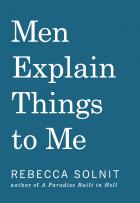lip lit: men explain things to me
In 2008 longtime activist, social commentator, and overall renaissance superwoman Rebecca Solnit made a splash in the feminist blogosphere with her post Men Explain Things to Me, a bold and quirky manifesto against male-on-female silencing. Ever since her wry critique hit the scene, Solnit has been dubbed the matriarch of mansplaining and has further cemented her work as required reading for all things feminist.
Now, six years later, her humble yet biting post is back for more. Solnit has cobbled together an essay sampler that packs a feminist punch in Men Explain Things to Me, available from Haymarket Books.
You might recall Solnit’s snappy prose and on-point wisdom from her work with Harper’s magazine or her other books. But for those still unfamiliar with her, all you need to know is that Rebecca Solnit has a fierce feminist and activist bent that has taken her all over the place—to the infamous and highly radioactive Nevada Test Site, to critique landscape and gender in art, and to the web as a loud-and-proud advocate for women everywhere.
In short, Men Explain Things to Me is the perfect breeze-read for newbies and Solnit-lovers alike, providing a little something for everyone in its wit and clarity. The book weighs in at a brisk 130 pages—with art by Ana Teresa Fernandez—which makes this skinny volume a great companion to a cup of vanilla rooibos and a few hours spent in your favorite comfy chair.
The book opens with Solnit’s seminal blog post ‘Men Explain Things to Me,’ and probes into a potpourri of feminist snippets on rape culture, the southwestern Native American lore of Grandmother Spider, and even Virginia Woolf. The essays are drawn together flawlessly and artfully by a thread of women’s silence and invisibility. Together, the writings pin down this dangerous phenomenon facing women everywhere—#YesAllWomen—and shine a ray of light on how to combat and reform that threat in a changing world.
The namesake essay, “Men Explain Things to Me,’ is Solnit’s quirky-critical diatribe against the men in our lives who talk knowingly and condescendingly to women, whether or not they know what they are talking about. The essay debuted as an observational blog post and caught traction as the perfect nut-shell summary of everything that’s wrong with gendered discourse. Here, Solnit unfurls a simple party scene and dishes dirt on the affluent, imposing man who attempted to explain one of her own books to her. In accessible yet knowing style, Solnit throws down a succinct and wry critique on how this simple, infantilizing experience is a dangerous form of silencing that not only pins women as mere listeners but also leads down a slick slope toward discrediting women who have stared rape, domestic violence, and other dire harm square in the face and dared to tell about it.
Solnit writes that ‘at the heart of the struggle of feminism to give rape, date rape, marital rape, domestic violence, and workplace sexual harassment legal standing as crimes has been the necessity of making women credible and audible,’ linking the silencing of women to rape culture. Then, in a glimmer of sass typical to Solnit’s charm, she adds—to the mansplaining partygoer from her opening anecdote—’Dude, if you’re reading this, you’re a carbuncle on the face of humanity and an obstacle to civilization. Feel the shame.’ Burn.
The other essays in the book reflect that same Solnit charm alongside weighty critique and analysis. In the piece ‘In Praise of the Threat,’ Solnit encourages readers to embrace the accusation that marriage equality is a threat to the family, rather than try to refute it. This position was jarring to me as someone who works for dialogue and mutual effort with the opposing sides when it comes to marriage equality, but Solnit makes a solid point in embracing the overthrow of the family as we know it. She argues how marriage has changed over the years—from coverture laws that made wives subservient to husbands to the slightly more egalitarian marriages enjoyed in many places today. When we, as activists, proclaim that marriage equality will indeed threaten the family as a status quo, Solnit says, we are celebrating the need for changes in the marital institution as a whole—changes that can make life better. Solnit argues that just as we needed to revise the marital oath for women to “love, honor, and obey,” there is still work to be done and ideas to throw out as we work toward a more perfect definition of family.
As a critic I am obliged to share the fallacies of the book, to illuminate the places where the logic tanked or the prose was yawn-worthy. But having burned through this afternoon read twice—which includes several punchy essays I haven’t introduced here—I can’t place this book as anything less than a brilliant, varied, and thoroughly enjoyable read—and definitely an addition to my list of feminist faves. With that, I urge you to get to your favorite bookshop or library and snag a copy of Men Explain Things to Me. Pull up a chair, brew something tasty, and venture into the wilderness of what a changed world might look like.



Thanks for this review, which makes me aware of Solnit’s (apparent) argument that a large component of the discourse on “family” is based on the historic male dominance built into the definition of “family” that opponents of “marriage equality” cling to in fear that this male dominance will be lost. Of course, the concept of equality requires the redefinition of family as something that can exist without male dominance. Calls to preserve “family” as it was are calls to preserve male dominance. (Of course, not all historic families were structured as male-dominant: some certainly varied from this social norm. It’s the “normal” that needs restructuring.)